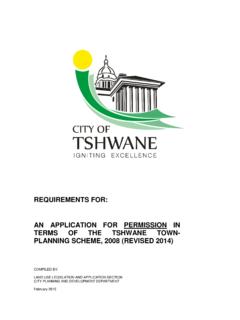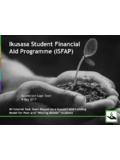Transcription of Provincial Land Use Legislative Reform Gauteng Province ...
1 Provincial Land Use Legislative Reform Gauteng Province : Status Report September 2011 Acknowledgements This report was written by Steve Baylis of VBH town planning (Pty) Ltd Special thanks to Ben van der Walt, Chief town and Regional Planner, Gauteng Department of Economic Development for serving as an external reader and providing useful comments to an initial draft of the report. Thanks to the officials in the Gauteng Department of Local Government and Housing and those of the municipalities of Mogale City, City of Johannesburg and City of Tshwane who participated in a workshop presentation of the report. Project management team consisted of Michael Kihato, Nellie Lester, Gemey Abrahams, Mpho Hlahla and Stephen Berrisford. The report was produced by the South African Cities Network secretariat consisting Sithole Mbanga, Letlhogonolo Dibe, Supriya Kalidas, Sadhna Bhana and Nenekazi Jukuda Table of Contents LIST OF FIGURES .. 1 LIST OF TABLES.
2 1 INTRODUCTION .. 2 Provincial Legislative STATUS QUO .. 3 PERFORMANCE OF Provincial LEGISLATION .. 27 STAKEHOLDER VIEWS OF Provincial planning LEGISLATION .. 28 OVERVIEW OF KEY ISSUES HAVING IMPLICATIONS ON Provincial planning LEGISLATION IN Gauteng .. 35 CONCLUSIONS AND RECOMMENDATIONS .. 37 REFERENCES .. 42 ANNEXURES .. 43 List of Figures Figure 1: Gauteng Province and District Municipalities .. 2 List of Tables Table 1: Acts to be repealed .. 22 Introduction This report aims to provide an understanding of the current land use management and spatial planning status quo in Gauteng Province , with the objective of contributing to the development of a more appropriate Legislative process for facilitating better land use management and delivery of development. Gauteng Province is the economic hub of the national economy. It is the most densely settled Province , and the smallest Province in country.
3 It comprises three metropolitan municipalities (Johannesburg, Tshwane and Ekurhuleni) and three District municipalities (which includes 9 local municipalities). The population, according to the Gauteng Spatial Development Framework (2010), is approximately 11 million. Figure 1: Gauteng Province and District Municipalities The purpose of this report is to review the state of the Province s Legislative framework, provide insight into the implementation of current laws and processes, obtain empirical information, conduct interviews with officials, highlight Provincial legislation issues, and provide conclusions that may influence future Provincial legislation. Provincial Legislative Status Quo History of the planning Laws Reform The Province inherited a racially-based spatial planning and land use management system, and notwithstanding the steps by the democratic government to address the legacy of this system by means of integrated planning , vestiges of the system remain.
4 There are two aspects that are covered briefly below, namely the land use management (regulatory) component of planning , and the forward planning component. With regard to the regulatory component, the Gauteng town - planning and Townships Ordinance No. 15 of 1986, ( Ordinance, 1986 ), applicable to former white , Indian , and coloured areas, is the main Provincial legislation relating to the development and regulation of land use. The Province , through the Ordinance, has authorized most municipalities to deal with land use regulation in their areas of jurisdiction, but this excludes former black areas or released areas in terms of the repealed Black Laws Amendment Act of 1949. The Townships Board and other statutory boards established by Province in terms of Ordinance 1986 deal with appeals and related matters. On the other hand, the traditional areas and former homelands, such as the ones found in the City of Tshwane, that are subject to a variety of customary and black areas laws relating to settlement, land use and different forms of tenure that were administered by Province , are not integrated into the municipal planning system.
5 One of the most significant attempts to address the fragmented land use management system was the introduction of the Development Facilitation Act ( DFA ) in 1995, a national level parallel law that could be implemented by provinces while addressing the much needed Reform of laws in their areas of jurisdiction. Gauteng implemented the DFA and was the Province with the most applications nationally. However, in the late 1990 s - early 2000 s many provinces began a process to develop their own Provincial planning legislation. In the case of Gauteng , this opportunity was taken and resulted in the promulgation in 2003 of the Gauteng planning and Development Act No 3 of 2003. It was an attempt to unify planning and regulatory processes in the Province . However, the regulations were never finalized, and the Act was not implemented, leaving the status quo unchanged. Work on a new revised Bill has reached an advanced stage and it is expected that a new Gauteng planning and Development Bill will be introduced to the legislature, possibly in 2012.
6 The DFA (1995) has become an alternative to the existing procedures, with a provincially appointed Development Tribunal to deal with land development area applications. The DFA (1995) has also provided a set of normative planning principles that are applicable to all land use decisions and are generally recognized as promoting a more sustainable form of development than previously catered for in concepts such as need and desirability that is used in the Gauteng town - planning and Townships Ordinance, 1986. Other innovative aspects included the composition of the Tribunal (technical experts from the public and private sectors), the responsibility placed on the applicant for assembling the requisite application information upon submission, the specified timeframes for activities, and the public involvement aspects. The Tribunal has functioned for a number of years, but a successful Constitutional Court challenge to its use for municipal planning mounted by the City of Johannesburg in 2009 has resulted in a marked reduction of applications under this Act.
7 It will effectively be discontinued by 18 June 2012, although the court order discontinued the DFA s application in the City of Johannesburg with immediate effect. With regards to forward planning , the Physical planning Act of 1967 was the primary pre-1994 instrument, providing for guide plans and structure plans. These plans have been superseded by various other forward planning instruments, such as the DFA (1995) Land Development Objectives, and most recently the introduction of integrated development plans (IDPs) in terms of the Municipal Systems Act in 2000 ( MSA ). The MSA (2000) IDPs include a mandatory spatial component in the form of spatial development frameworks (SDFs) to direct municipal planning decisions and developmental interventions. Regulation 2(4) of the Municipal planning and Performance Management Regulations (2001) added further details to the spatial development requirements including the need to: give effect to the DFA principles; set out objectives for the desired spatial form of the municipality; contain strategies and policies to achieve the desired spatial form; set out basic guidelines for the land use management system; set out a capital investment framework for the municipality s development programmes; be aligned with the spatial development frameworks of neighbouring municipalities; and provide a visual representation to indicate where public and private land development and infrastructure investment should take place, the desired or undesired use of space, the urban edge, areas where intervention should take place, and areas where priority spending is required.
8 More recently, in April 2011, the national government published the Spatial planning and Land Use Management Bill (2011) (SPLUMB)-a revision of the 2008 Bill- that is intended as framework legislation to regulate land use planning throughout the country. It supports the implementation of Provincial planning legislation by the Provinces. From the above, it is clear that there has been a gradual move towards a more effective and uniform set of planning laws that match the constitutional requirements of the country. However, there remain numerous aspects of the current fragmented legal and institutional arrangement that need Reform to facilitate a better and more integrated land use planning system. Description of the Current Applicable planning Legislation The following description of acts provides an overview of currently applicable planning legislation as discussed with Mr B van der Walt of Land Use Management and Statutory Boards, Gauteng Department of Economic Development, and Mrs H Smith of Township Establishment, Gauteng Department of Housing and Local Government (Pers.)
9 Comm., 31 May 2011). The list illustrates the plethora of laws applicable to spatial planning and land use management in the Province and the different institutional responsibilities creating inherent difficulties in the system for achieving efficient and sustainable development. a) Transvaal town - planning and Townships Ordinance No. 25 of 1965 ( Old Ordinance ) Administered by Province (Department of Economic Development). Comment: Prior to 1986, Province administered town planning in the former Transvaal. There are about 500 township applications in the system, the validity of which is extended annually. There is no mechanism to transfer these to the affected municipalities. The historical records of old permissions granted have not been fully transferred to municipalities. b) town - planning and Townships Ordinance of 1986 ( New Ordinance ) The Ordinance provides guidance as to the purpose of town planning , the regulation of land use by town planning schemes (including the content and application procedures), the establishment of townships, and the roles and functions of statutory boards.
10 Most municipalities are authorized by Province in terms of s2 of the Ordinance for the purposes set out in chapters II ( town planning schemes), III (Establishment of townships by private land owner), and IV (Establishment of townships by local authority). In effect, they can consider, approve, or refuse land use applications. The criteria used for decision-making include municipal policies, need and desirability, and more recently, the normative principles in the Development Facilitation Act. The Provincial Department of Economic Development, through its statutory boards, deals with appeals against municipal decisions for undue delay by municipalities in dealing with applications, disputes on merit, services contributions, and extensions of township boundaries. These are long processes, and generally require hearings and input from the municipalities. Comment: The municipalities are geared for procedures in terms of the Ordinance, but need to embrace the wider scope of their jurisdictions by introducing new land use management schemes.




